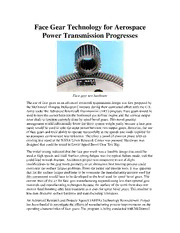
NASA Technical Reports Server (NTRS) 20050170033: Face Gear Technology for Aerospace Power Transmission Progresses PDF
Preview NASA Technical Reports Server (NTRS) 20050170033: Face Gear Technology for Aerospace Power Transmission Progresses
Face Gear Technology for Aerospace Power Transmission Progresses Face gear test hardware The use of face gears in an advanced rotorcraft transmission design was first proposed by the McDonnell Douglas Helicopter Company during their contracted effort with the U.S. Army under the Advanced Rotorcraft Transmission (ART) program. Face gears would be used to turn the corner between the horizontal gas turbine engine and the vertical output rotor shaft--a function currently done by spiral bevel gears. This novel gearing arrangement would substantially lower the drive system weight partly because a face gear mesh would be used to split the input power between two output gears. However, the use of face gears and their ability to operate successfully at the speeds and loads required for an aerospace environment was unknown. Therefore a proof-of-concept phase with an existing test stand at the NASA Lewis Research Center was pursued. Hardware was designed that could be tested in Lewis' Spiral Bevel Gear Test Rig. The initial testing indicated that the face gear mesh was a feasible design that could be used at high speeds and load. Surface pitting fatigue was the typical failure mode, and that could lead to tooth fracture. An interim project was conducted to see if slight modifications to the gear tooth geometry or an alternative heat treating process could overcome the surface fatigue problems. From the initial and interim tests, it was apparent that for the surface fatigue problems to be overcome the manufacturing process used for this component would have to be developed to the level used for spiral bevel gears. The current state of the art for face gear manufacturing required using less than optimal gear materials and manufacturing techniques because the surface of the tooth form does not receive final finishing after heat treatment as it does for spiral bevel gears. This resulted in less than desirable surface hardness and manufacturing tolerances. An Advanced Research and Projects Agency (ARPA) Technology Reinvestment Project has been funded to investigate the effects of manufacturing process improvements on the operating characteristics of face gears. The program is being conducted with McDonnell Douglas Helicopter Co., Lucas Western Inc., the University of Illinois at Chicago, and a NASA/U.S. Army team. The goal of the project is develop the grinding process, experimentally verify the improvement in face gear fatigue life, and conduct a full-scale helicopter transmission test. The theory and methodology to grind face gears has been completed, and manufacture of the test hardware is ongoing. Experimental verification on test hardware is scheduled to begin in fiscal 1996. Bibliography Handschuh, R.; Lewicki, D.; and Bossler, R.: Experimental Testing of Prototype Face Gears for Helicopter Transmissions. NASA TM-105434, 1992. Heath, G.F.; and Bossler, R.B.: Advanced Rotorcraft Transmission (ART) Program. Final Report. NASA CR-191057, 1993.
